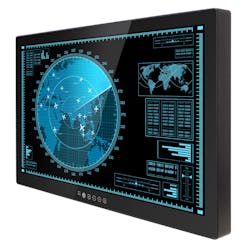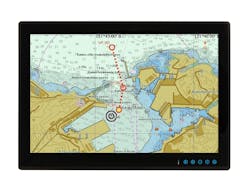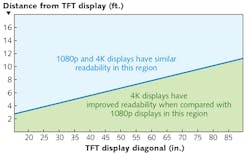Novel Displays: 4K TFT displays maximize pixel density for high-definition applications
TONY ZUCARELLI, BRAD LIZOTTE, and KEN WERNER
High-definition (HD), thin-film-transistor (TFT)-based, liquid-crystal displays (LCDs) termed "4K" have become the standard in the majority of commercially available televisions, with prices similar to lower-resolution 1080p monitors. Today, consumers are enjoying 52 in. high-definition televisions (HDTVs) for prices as low as $600 at most major retail outlets. Because of the high demand being created in the consumer TV market, TFT displays in HD resolutions—and the supporting drive technologies—are now readily available for use in applications in the industrial, defense, and marine/aerospace market segments.
With a factor-of-four increase in pixel density from the standard 1920 × 1080 for a 1080p monitor to a 3840 × 2160 capability, the 4K display derives its name from the 3840 horizontal pixel count rounded up to 4000, or 4K. Among the obvious resolution improvement and pixel-count increase to nearly 8.3 Mpixels to reach HD status, 4K displays have numerous other attributes that are not only desired by the consumer display market, but are oftentimes required by more rigorous industrial and scientific customers (see Fig. 1).
Building a 4K display
In applications like air traffic control displays and on the bridge of expensive yachts or commercial boats monitoring ocean floor details or land- and sea-based obstructions, images are better defined and easier to read using 4K displays because they are mapped at four times the pixel density (see Fig. 2).The first 4K camera released by Dalsa (Waterloo, ON, Canada) in 2003 drove the demand for HD displays. Despite Sony's (Tokyo, Japan) release of 4K video projectors in 2004 and YouTube (San Bruno, CA) support of 4K video uploads in 2010, 4K adoption was slow. The first commercial introduction of a 4K TFT television was made by LG (Seoul, South Korea) in 2012 at a sales price just under $20,000.
Compared to a 2K panel of the same size, a 4K panel pixel pitch is one half, the width and height is one half, and the pixel area is one quarter the size. This places greater demands on the photolithography processes used to pattern the TFTs that control the intensity of each sub-pixel, as well as the matrix color filter that sits on the front surface of the display and gives each of the sub-pixels its required red, green, or blue color. Another 4K demand is that the fan-outs from the driver integrated circuits and all of the signal busses must be thinner and more closely spaced.
Although initially challenging, these issues have been largely solved. Indeed, they have been solved so well that premium 4K desktop monitors are now appearing that have diagonals of 28 in.
A less obvious issue-unless you're in the display business-is that the most common material for making TFTs for medium and large displays is amorphous silicon (a-Si). Although inexpensive and reliable, a-Si is a rather poor semiconductor, meaning that each TFT must be relatively large if it is to deliver adequately fast switching times.
When the sub-pixels are made smaller, the TFT accounts for a larger percentage of the pixel area, which means a smaller area is available for the transmission of light. This requires a brighter backlight and larger power consumption if screen brightness is to be maintained, or it requires that the designer (and the end user) accept a display that is less bright.
Fortunately, a-Si TFTs are adequate for larger-format display monitors. However, mobile-phone displays require a higher-quality TFT material such as low-temperature polysilicon (LTPS) or indium gallium zinc oxide (IGZO) that permit the TFT to be smaller and the percentage of the sub-pixel that can transmit light (the "aperture ratio") to be larger.
Imaging flexibility
For surveillance and machine-vision applications, among many others, more rapid information review is possible when using 4K displays by splitting the screen into four image fields. These split images do not lose clarity or contrast when compared with the singular image on a 1080p format monitor, enabling the user to look at four images simultaneously.
Because the map field is four times larger, it does require the content to be developed in the same resolution to take full advantage of its benefits. That is, an image must be gathered with at least 3840 horizontal pixels for it to be viewed at full resolution on a 4K monitor. Conversely, an image developed for a 1080p display can be "translated," with each of the approximately 1000 image pixels mapped from one to four pixels. However, there is no display advantage here, as these mapped images will have a very similar appearance when displayed on a 1080p or a 4K monitor.
Another advance that has played a key role in the acceptance of 4K display technology is local dimming, which enables the reduction in light output in specific pixel groups. This is important in increasing the saturation of black images, which in turn increases the contrast with other colors in the display. Contrast is measured as a ratio in intensity between blacks and whites. With localized dimming, it is possible to make a black pixel more "black" by dimming the backlight locally. A true black increases the contrast ratio and makes the display easier to read.
There are currently two types of LED backlit displays being sold: those with edge-lit LED backlights and those with LED arrays. Local dimming is only possible with an LED array backlight because each LED emits directly into the LCD. There are also other advantages for an LED array backlight. Fewer LEDs results in lower power consumption, higher brightness, and improved contrast. The only downside is the array requires more thickness to allow for light spread.
Managing data bandwidth
While images mapped with a 4X increase in pixel density will have higher resolution, the increased pixel data needs to be properly managed. With previous 1080p screen resolutions, images were mapped to 2.07 Mpixels. With 4K HD monitors, however, images are mapped to nearly 8.3 Mpixels, putting additional demands on video card capacity. This means that the total content on any HD monitor requires four times the signal bandwidth to display an image on a screen when compared to 1080p resolutions (see Fig. 3).Another advance in LCDs introduced at about the same time as 4K is higher refresh rate. Image refresh rates have recently increased from 60 to as much as 240 Hz, with increased refresh speeds reducing image tears (a portion of the image is skewed to the left or right in the horizontal axis) or streaking (when the image bit map is completely randomized and an unrecognizable image is displayed). This becomes more important when displaying images at higher speeds.
When designing for higher refresh frequencies, it is important that the video card matches the refresh speed of the monitor-otherwise, the monitor and source will not sync and the dreaded blue screen will display a "no signal" message. Some controller cards feature variable frequencies.
The marine group of Aydin Displays recently released two 4K monitors in November 2016 with 27 and 32 in. display sizes. These monitors feature picture-in-picture (up to four images), optically bonded touch screens, and optional high-brightness versions designed to meet the rigors of marine installations.
Optical bonding eliminates the air gap that can exist between the rear of the touch screen and the front of the LCD. It also reduces the light-reflective surfaces from three to one and the total reflected light from 13.2% to around 0.2%. The result is less optical distortion and increased contrast and readability. Also, much like plywood, optical bonding adds strength to the display's structure, allowing exposure to greater stress without damage.
Aydin's defense engineering group will introduce even larger 34 and 40 in. 4K displays later this year.
Tony Zucarelli is engineering product manager and Brad Lizotte is national accounts manager, both at Aydin Displays, Birdsboro, PA; e-mail: [email protected]; www.aydindisplays.com, while Ken Werner is a past editor-in-chief of Information Display magazine and currently president and founder of Nutmeg Consultants, Norwalk, CT; www.nutmegconsultants.com.


